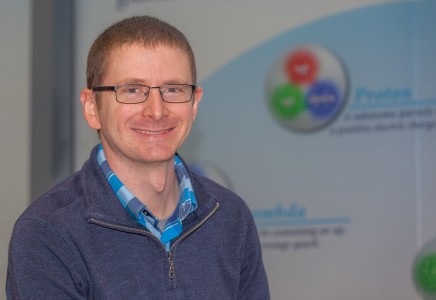When planning began for Jefferson Lab’s Gluonic Excitations Experiment (GlueX) in the early 1990s, Justin Stevens was in elementary school. He had no idea that one day he would help design a critical detector for phase two of the multi-decade project or that he would play the critical role of physics analysis coordinator.
Stevens began his career at Indiana University, where he conducted research at the U.S. Department of Energy’s Brookhaven National Laboratory in pursuit of his Ph.D. From there, he moved to Boston in 2012 for a postdoctoral position at the Massachusetts Institute of Technology.
It was during his time at MIT that he began working on the conceptual design for a detector critical for phase two of GlueX, the DIRC (Detection of Internally Reflected Cherenkov light) detector. GlueX began data taking with the completed detector in December 2019.
Multi-institution coordination
While developing the DIRC detector at MIT and later as a staff scientist at Jefferson Lab, Stevens had his first taste of what his future on the GlueX project would be like. He discovered that he could have a pivotal role in the project by combining his instincts for project management with his cross-institution coordination skills. Much of his success in his role has come from his willingness to take on the management side of an experiment in addition to the research itself.
“Our team at MIT was putting together a proposal for what the detector would look like,” he recalls. “We were looking at our options and it turned out that a significant component of the detector was available at DOE’s SLAC National Accelerator Laboratory in California. These were components that were quite expensive to build—five-meter-long silica bars that were very challenging to machine and keep polished. They weren’t being used at SLAC anymore.”
The GlueX collaboration put in a request to use the bars at Jefferson Lab. The request was approved, so the team got to work determining the safest way to transport the fragile material from California to their future home in Hall D at Jefferson Lab. To ensure the successful transportation of the bars, Stevens worked with a group at MIT and Indiana University to build well-cushioned crates that would be pulled across the country by a semi-trailer.
Learning on the job
Stevens says he has learned additional project management skills through his work on GlueX. In 2016, he assumed a three-year bridge appointment position at Jefferson Lab and William & Mary. A bridge appointment is a reciprocal relationship that Jefferson Lab has with local universities whereby the lab helps to fund faculty positions at universities in exchange for having those faculty members and their students research at the lab.
He admits that the position permitted him to learn much about his roles by being on the job.
“As a physicist, we do a little bit of everything,” he explains. “The lab has an extremely good group of engineers that are good at designing and engineering the specifications for the detector we’re interested in. When I was hired by the lab, part of my job was to manage this $1.8 million project. There were things like budgeting and procurement that I had to learn on the fly.”
Stevens says he turned to his colleagues at the lab for guidance.
“Project management of these large experiments is not something we learn as physics graduate students,” Stevens admits. “Part of my job description was to make this detector a reality and to do that, we had to negotiate with the lab for funding to build the device, work with universities and establish a manageable timeline for the project. I had a lot to learn and an excellent team at the lab to help guide me.”
Encouraging future scientists
Now, as an assistant professor at William & Mary, Stevens continues to include his students on research at the lab, where they can learn hands-on.
“There are unique advantages of having a big, national laboratory nearby William & Mary,” Stevens says. “The undergraduate students that work with me at William & Mary can come with me to the lab. An undergraduate student across the country can do analysis, but not actually see the experiment they’re working on.”
Stevens reports that in addition to the undergraduate and graduate students in the William & Mary physics department, there are roughly 60 physics Ph.D. candidates and nine faculty members working on nuclear physics at the school.
Stevens says that he intends to continue to enable physics students to contribute to the lab’s experiments in meaningful ways.
“Phase two of GlueX that uses this new detector should take about four years to run to completion,” he explains. “It’s a long experiment and it takes time to process and analyze the data. My graduate students will have several years of data analysis on this experiment alone, and I expect that I will have students analyzing data from GlueX for a decade.”
By Carrie Rogers


